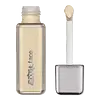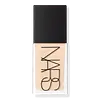What's inside
What's inside
 Key Ingredients
Key Ingredients

 Benefits
Benefits

 Concerns
Concerns

 Ingredients Side-by-side
Ingredients Side-by-side

Water
Skin ConditioningCoco-Caprylate/Caprate
EmollientGlycerin
HumectantDicaprylyl Ether
EmollientButylene Glycol
HumectantIsododecane
EmollientHydrogenated Polycyclopentadiene
Polyglyceryl-4 Isostearate
EmulsifyingCaprylic/Capric Triglyceride
MaskingPolyglyceryl-2 Dipolyhydroxystearate
Skin ConditioningHydrogenated Polyisobutene
EmollientDisteardimonium Hectorite
StabilisingMagnesium Sulfate
Pentylene Glycol
Skin ConditioningPhenoxyethanol
PreservativeMica
Cosmetic ColorantSilica
AbrasiveSorbitan Isostearate
EmulsifyingGaultheria Procumbens Leaf Extract
PerfumingHydrogenated Lecithin
EmulsifyingPropylene Carbonate
SolventSodium Hydroxide
BufferingTocopheryl Acetate
AntioxidantChlorella Sorokiniana Extract
Skin ConditioningEthylhexylglycerin
Skin ConditioningEthylene/Propylene/Styrene Copolymer
Butylene/Ethylene/Styrene Copolymer
Yeast Extract
Skin ConditioningTrisodium Ethylenediamine Disuccinate
1,2-Hexanediol
Skin ConditioningCaprylyl Glycol
EmollientSodium Carbonate
BufferingTocopherol
AntioxidantPentaerythrityl Tetra-Di-T-Butyl Hydroxyhydrocinnamate
AntioxidantCI 77891
Cosmetic ColorantCI 77491
Cosmetic ColorantCI 77492
Cosmetic ColorantCI 77499
Cosmetic ColorantWater, Coco-Caprylate/Caprate, Glycerin, Dicaprylyl Ether, Butylene Glycol, Isododecane, Hydrogenated Polycyclopentadiene, Polyglyceryl-4 Isostearate, Caprylic/Capric Triglyceride, Polyglyceryl-2 Dipolyhydroxystearate, Hydrogenated Polyisobutene, Disteardimonium Hectorite, Magnesium Sulfate, Pentylene Glycol, Phenoxyethanol, Mica, Silica, Sorbitan Isostearate, Gaultheria Procumbens Leaf Extract, Hydrogenated Lecithin, Propylene Carbonate, Sodium Hydroxide, Tocopheryl Acetate, Chlorella Sorokiniana Extract, Ethylhexylglycerin, Ethylene/Propylene/Styrene Copolymer, Butylene/Ethylene/Styrene Copolymer, Yeast Extract, Trisodium Ethylenediamine Disuccinate, 1,2-Hexanediol, Caprylyl Glycol, Sodium Carbonate, Tocopherol, Pentaerythrityl Tetra-Di-T-Butyl Hydroxyhydrocinnamate, CI 77891, CI 77491, CI 77492, CI 77499
Water
Skin ConditioningC9-12 Alkane
SolventButylene Glycol
HumectantUndecane
EmollientTridecane
PerfumingIsodecyl Neopentanoate
EmollientHydrogenated Polyisobutene
EmollientPolyglyceryl-6 Polyricinoleate
EmulsifyingPolyglyceryl-2 Diisostearate
EmulsifyingDisteardimonium Hectorite
StabilisingDiisostearyl Malate
EmollientGlycerin
HumectantSynthetic Wax
AbrasiveSodium Chloride
MaskingOphiopogon Japonicus Root Extract
Skin ConditioningAscophyllum Nodosum Extract
Skin ConditioningTheobroma Cacao Seed Extract
AntioxidantCurcuma Longa Root Extract
MaskingSilybum Marianum Fruit Extract
Skin ConditioningAluminum Hydroxide
EmollientMagnesium Chloride
Sodium Dilauramidoglutamide Lysine
HumectantTocopherol
AntioxidantCoco-Caprylate/Caprate
EmollientEthylhexylglycerin
Skin ConditioningPentylene Glycol
Skin ConditioningHydroxyphenyl Propamidobenzoic Acid
Skin ConditioningAscorbyl Palmitate
AntioxidantCitric Acid
BufferingSea Water
HumectantTrisodium EDTA
CI 77120
Cosmetic ColorantAlumina
AbrasiveChlorphenesin
AntimicrobialPhenoxyethanol
PreservativePotassium Sorbate
PreservativeIron Oxides
Mica
Cosmetic ColorantCI 77891
Cosmetic ColorantWater, C9-12 Alkane, Butylene Glycol, Undecane, Tridecane, Isodecyl Neopentanoate, Hydrogenated Polyisobutene, Polyglyceryl-6 Polyricinoleate, Polyglyceryl-2 Diisostearate, Disteardimonium Hectorite, Diisostearyl Malate, Glycerin, Synthetic Wax, Sodium Chloride, Ophiopogon Japonicus Root Extract, Ascophyllum Nodosum Extract, Theobroma Cacao Seed Extract, Curcuma Longa Root Extract, Silybum Marianum Fruit Extract, Aluminum Hydroxide, Magnesium Chloride, Sodium Dilauramidoglutamide Lysine, Tocopherol, Coco-Caprylate/Caprate, Ethylhexylglycerin, Pentylene Glycol, Hydroxyphenyl Propamidobenzoic Acid, Ascorbyl Palmitate, Citric Acid, Sea Water, Trisodium EDTA, CI 77120, Alumina, Chlorphenesin, Phenoxyethanol, Potassium Sorbate, Iron Oxides, Mica, CI 77891
 Reviews
Reviews

Ingredients Explained
These ingredients are found in both products.
Ingredients higher up in an ingredient list are typically present in a larger amount.
Butylene Glycol (or BG) is used within cosmetic products for a few different reasons:
Overall, Butylene Glycol is a safe and well-rounded ingredient that works well with other ingredients.
Though this ingredient works well with most skin types, some people with sensitive skin may experience a reaction such as allergic rashes, closed comedones, or itchiness.
Learn more about Butylene GlycolCi 77891 is a white pigment from Titanium dioxide. It is naturally found in minerals such as rutile and ilmenite.
It's main function is to add a white color to cosmetics. It can also be mixed with other colors to create different shades.
Ci 77891 is commonly found in sunscreens due to its ability to block UV rays.
Learn more about CI 77891Coco-Caprylate/Caprate is created from fatty coconut alcohol, caprylic acid, and capric acid.
It is a lightweight emollient. Emollients create a thin barrier on the skin to trap moisture in. This helps keep your skin hydrated and soft.
Once applied, Coco-Caprylate/Caprate is absorbed quickly and leaves a silky feel.
Coco-Caprylate/Caprate may not be fungal acne safe.
Learn more about Coco-Caprylate/CaprateDisteardimonium Hectorite comes from the clay mineral named hectorite. It is used to add thickness to a product.
It can also help stabilize a product by helping to disperse other ingredients.
Hectorite is a rare, white clay mineral.
Learn more about Disteardimonium HectoriteEthylhexylglycerin (we can't pronounce this either) is commonly used as a preservative and skin softener. It is derived from glyceryl.
You might see Ethylhexylglycerin often paired with other preservatives such as phenoxyethanol. Ethylhexylglycerin has been found to increase the effectiveness of these other preservatives.
Glycerin is already naturally found in your skin. It helps moisturize and protect your skin.
A study from 2016 found glycerin to be more effective as a humectant than AHAs and hyaluronic acid.
As a humectant, it helps the skin stay hydrated by pulling moisture to your skin. The low molecular weight of glycerin allows it to pull moisture into the deeper layers of your skin.
Hydrated skin improves your skin barrier; Your skin barrier helps protect against irritants and bacteria.
Glycerin has also been found to have antimicrobial and antiviral properties. Due to these properties, glycerin is often used in wound and burn treatments.
In cosmetics, glycerin is usually derived from plants such as soybean or palm. However, it can also be sourced from animals, such as tallow or animal fat.
This ingredient is organic, colorless, odorless, and non-toxic.
Glycerin is the name for this ingredient in American English. British English uses Glycerol/Glycerine.
Learn more about GlycerinHydrogenated Polyisobutene is a synthetic polymer. Polymers are compounds with high molecular weight. Hydrogenated Polyisobutene is an emollient and texture enhancer.
In one study, Hydrogenated Polyisobutene showed better skin hydration levels than Caprylic/Capric Triglyceride. As an emollient, it helps keep your skin soft and hydrated by trapping moisture in.
Hydrogenated Polyisobutene is often used as a mineral oil replacement.
Learn more about Hydrogenated PolyisobuteneMica is a naturally occurring mineral used to add shimmer and color in cosmetics. It can also help improve the texture of a product or give it an opaque, white/silver color.
Serecite is the name for very fine but ragged grains of mica.
This ingredient is often coated with metal oxides like titanium dioxide. Trace amounts of heavy metals may be found in mica, but these metals are not harmful in our personal products.
Mica has been used since prehistoric times throughout the world. Ancient Egyptian, Indian, Greek, Roman, Aztec, and Chinese civilizations have used mica.
Learn more about MicaPentylene glycol is typically used within a product to thicken it. It also adds a smooth, soft, and moisturizing feel to the product. It is naturally found in plants such as sugar beets.
The hydrophilic trait of Pentylene Glycol makes it a humectant. As a humectant, Pentylene Glycol helps draw moisture from the air to your skin. This can help keep your skin hydrated.
This property also makes Pentylene Glycol a great texture enhancer. It can also help thicken or stabilize a product.
Pentylene Glycol also acts as a mild preservative and helps to keep a product microbe-free.
Some people may experience mild eye and skin irritation from Pentylene Glycol. We always recommend speaking with a professional about using this ingredient in your routine.
Pentylene Glycol has a low molecular weight and is part of the 1,2-glycol family.
Learn more about Pentylene GlycolPhenoxyethanol is a preservative that has germicide, antimicrobial, and aromatic properties. Studies show that phenoxyethanol can prevent microbial growth. By itself, it has a scent that is similar to that of a rose.
It's often used in formulations along with Caprylyl Glycol to preserve the shelf life of products.
Tocopherol (also known as Vitamin E) is a common antioxidant used to help protect the skin from free-radicals and strengthen the skin barrier. It's also fat soluble - this means our skin is great at absorbing it.
Vitamin E also helps keep your natural skin lipids healthy. Your lipid skin barrier naturally consists of lipids, ceramides, and fatty acids. Vitamin E offers extra protection for your skin’s lipid barrier, keeping your skin healthy and nourished.
Another benefit is a bit of UV protection. Vitamin E helps reduce the damage caused by UVB rays. (It should not replace your sunscreen). Combining it with Vitamin C can decrease sunburned cells and hyperpigmentation after UV exposure.
You might have noticed Vitamin E + C often paired together. This is because it is great at stabilizing Vitamin C. Using the two together helps increase the effectiveness of both ingredients.
There are often claims that Vitamin E can reduce/prevent scarring, but these claims haven't been confirmed by scientific research.
Learn more about TocopherolWater. It's the most common cosmetic ingredient of all. You'll usually see it at the top of ingredient lists, meaning that it makes up the largest part of the product.
So why is it so popular? Water most often acts as a solvent - this means that it helps dissolve other ingredients into the formulation.
You'll also recognize water as that liquid we all need to stay alive. If you see this, drink a glass of water. Stay hydrated!
Learn more about Water